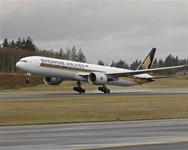Boeing's 777 health check software gains air time

Boeing has announced that Singapore Airlines will be the first airline to operate its maintenance and performance software across its fleet of Boeing 777s.

A Singapore Airlines 777 Credit: Boeing
According to Boeing, the airline recently finished evaluating the software, Electronic Logbook (ELB), on its fleet of 777s. ELB is part of Boeing's Class 3 Electronic Flight Bag software suite which includes features such as electronic charts and aircraft performance evaluation.
The ELB, in conjunction with Boeing's Airplane Health Management software will allow Singapore Airlines to "position people and equipment in the right place at the right time", according to Boeing, in a bid to increase operational efficiency and lower costs.
The ELB links maintenance and flight operations by forwarding fault reports from the air to the ground, so maintenance teams there can be ready to perform maintenance when the plane lands.
Before the flight, the software contains information on repairs which need to be done, those which will be deferred, aircraft fault history and the plane's maintenance release.
During the flight, the crew reports flight faults using a graphical "fault finder", assigning the problem a specific code depending on the type of fault, which helps maintenance crews reduce the need for troubleshooting and also the number of unscheduled line replaceable unit removals -- taking out a complex component of a plane that is designed to be replaced quickly at the airport -- according to Boeing.
Because maintenance planners know exactly what ails the plane before it lands, they are able to organise the right resources -- people or parts -- for its arrival. Maintenance crews access the data using a laptop interface, reviewing the logbook information to make necessary maintenance decisions while a maintenance control interface is used to monitor the logbook status of an entire fleet.
Boeing is not the only aircraft manufacturer looking to implement software to enable better aircraft maintenance. Critical Software recently announced it is developing a Health and Usage Monitoring System (HUMS) for ground stations, under contract to helicopter manufacturer AgustaWestland.
HUMS will be an installation free Web-based processing and analysis system which can interact with most current maintenance management systems, exchanging and synchronising health and usage data so that management can make decisions based on real-time information.
Data from sensors and accelerometers, which record forces on the plane, monitoring essential components of the aircraft, is collected and communicated using the system. Algorithms are applied to individual component data, determining damage and life expectancy for each individual part. By monitoring engine health and other critical components and checking for abnormal system responses the system detects failures, reducing damage to the aircraft and possibly saving lives.
Although the system was designed to support rotary wing aircraft, a spokesperson for Critical Software said the idea can be used in any other means of transport.